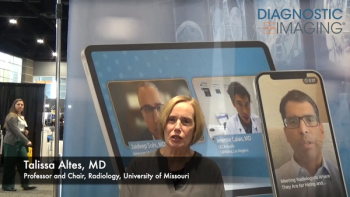
High-resolution CT accurately diagnoses shin splints
MRI should be the first test to evaluate athletes with lower leg pain, but if suspicion of shin splints is high, high-resolution CT can accurately diagnose the problem, according to a study conducted at the University of Messina in Italy.
MRI should be the first test to evaluate athletes with lower leg pain, but if suspicion of shin splints is high, high-resolution CT can accurately diagnose the problem, according to a study conducted at the University of Messina in Italy.
Medial tibial stress syndrome, or shin splints, accounts for 13.2% to 17.3% of all running injuries. Other lower leg overuse injuries with overlapping presenting features include chronic exertional compartment syndrome, tendinitis, stress fractures, fascial defects, and musculotendinous junction disruption, or tennis leg.
CT might be a reasonable clinical answer to make a distinction among the various running injuries, according to the study published in the September issue of American Journal of Roentgenology.
Dr. Michele Gaeta and colleagues performed high-resolution CT of both tibiae on 41 subjects: 20 asymptomatic distance runners, 11 symptomatic distance runners with unilateral or bilateral pain due to medial tibial stress syndrome (14 painful tibiae), and 10 volunteers not involved in a sport.
Among the distance runners, CT abnormalities were found in 14 of 14 (100%) painful tibiae and in eight (16.6%) of 48 painless tibiae. The difference was statistically significant.
"The study demonstrates that CT is capable of revealing cortical abnormalities in medial tibial stress syndrome, thus representing a reliable diagnostic tool in patients with leg pain," said coauthor Dr. Fabio Minutoli of the university's department of radiological sciences.
Sensitivity, specificity, positive predictive value, negative predictive value, and accuracy of CT in diagnosing medial tibial stress syndrome were 100%, 88.2%, 63.6%, 100%, and 90.2%, respectively.
"The results are useful for the management of athletes, particularly long-distance runners. Moreover, we think that CT can be used in research studies to evaluate other subtle bone abnormalities; for example, it can be useful in studies concerning osteoporosis," Minutoli said.
All CT examinations were performed using a Somatom Sensation 16 CT scanner from Siemens Medical Solutions. Two experienced musculoskeletal radiologists evaluated exams in consensus.
Researchers then classified the abnormalities:
- type 0: no abnormality
- type 1: small, scattered area of slightly reduced cortical attenuation without clear findings of osteopenia
- type 2: cortical osteopenia without or with cavitations, striations, or both cavitations and striations
All 14 painful tibiae were classified as type 2, while five tibiae of the 20 asymptomatic runners and three painless tibiae of symptomatic runners met that classification.
Forty-three of 43 tibiae classified as type 0, and 17 of 17 tibiae classified as type 1 were painless. On the other hand, 14 of 22 tibiae classified as type 2 were painful.
Researchers noted that their study supports recent findings that shin splints are not an inflammatory process of the periosteum but instead a bone stress reaction that has become painful.
They consider their results evidence that bone remodeling always precedes pain and therefore is highly likely to be the cause of symptoms.
"Clinically, our results indicate that CT has a high sensitivity in detecting abnormalities of the tibial cortex both in patients with medial tibial stress syndrome and in distance runners with presymptomatic bone remodeling," the authors said.
They suggest that MRI be the first exam for athletes with lower leg pain. If that test is nondiagnostic or in cases of strong suspicion of shin splints, CT should be considered.
For more from the Diagnostic Imaging archives:
Newsletter
Stay at the forefront of radiology with the Diagnostic Imaging newsletter, delivering the latest news, clinical insights, and imaging advancements for today’s radiologists.




























